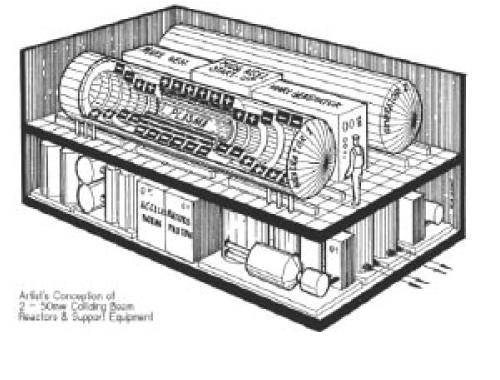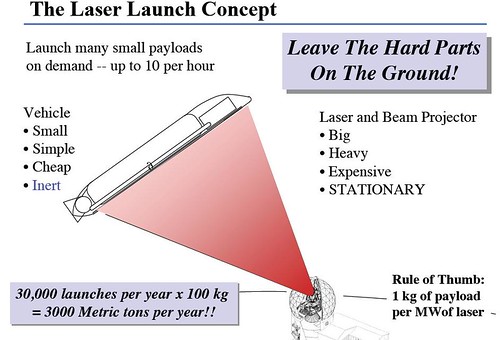Mark Whittington had a submission for the week 16 space carnival on what could happen in 2057 for space The following is my scenario for space in 2057. At the end of this article, I provide pointers to key projects that should be pursued to enable this version of Space in 2057.
Developing key technologies such as molecular nanotechnology, advanced fission and fusion for energy and propulsion would open the solar system and provide a leap in available power greater than the move from small steam engines of the 19th century to 20th century power plants. These are the major technologies that are needed to fully realize the next level of human capability. Trying to achieve space applications without these technologies is like people trying to be creative with pullies and levers and hand dug canals before the advent of steam engines. You can do a lot but it is harder and more limited.
Projecting a future 50 years from now without these technologies would be like projecting the capabilities of a baby fifties into the future who never learns to walk or develops manipulative skills beyond toy blocks or develops cognitive skills beyond a five year old level. A lot more effort and resources should be put into developing the key capabilities instead of day to day hand to mouth needs. By not developing these technologies we would have a severely crippled future with more dangers caused by the lack of capabilities.
You will also notice that I do not discuss any of current chemical rocket engine plans or efforts. While those are useful and I encourage these efforts (especially the establishment of industries like tourism in space), the efforts translate to how fast we are rolling while the engine is shutoff at the start of the Indy 500 or how fast people are rolling on the ground with their hands and feet tied. For true success, the plans need to start with untieing ourselves or starting the engine or in this case developing the key technologies (or using existing key technologies like nuclear fission to its full potential.)
Here are some predictions that I had made in early 2006
The critical predictions and assumptions for any future scenario and in particular space 2057 are:
What happens with moderately advanced nanotechnology like carbon nanotubes ?
What happens with advanced nanotechnology like molecularly precise nanofactories?
How hard do things like peak oil and climate change hit ?
Does some other catastrophe strike ?
What happens with energy ? nuclear fusion ? mass produced nuclear fission ?
What happens with Artificial intelligence, computers, and quantum computers ?
For this scenario, I will be following trends which indicate that all of these key technologies work out fairly well. A huge number of details need to be worked on very hard, but once we clear certain technological hurdles the avalanche of technological capability will start and what is possible economically will radically change.
I have already reviewed the announced projects for carbon nanotube factories, which will be producing 6,000+ tons/year in 2012. Up from 60 tons/year now. Prices will drop from $100-50,000/kg to $1-100/kg Prices will drop even more in the years after 2012 and volumes of production will also increase.


Nanofactory would use convergent and exponential assembly.
In convergent assembly, an assembly line of progressively larger manipulator arms assembles product subcomponents and passes them onto the next stage of larger manipulator arms, until finally a human-usable product is created.
Exponential assembly is a manufacturing architecture starting with a single tiny robotic arm on a surface. This first robotic arm makes a second robotic arm on a facing surface by picking up miniature parts — carefully laid out in advance in exactly the right locations so the tiny robotic arm can find them — and assembling them. The two robotic arms then make two more robotic arms, one on each of the two facing surfaces. These four robotic arms, two on each surface, then make four more robotic arms. This process continues with the number of robotic arms steadily increasing in the pattern 1, 2, 4, 8, 16, 32, 64, etc. until some manufacturing limit is reached (both surfaces are completely covered with tiny robotic arms, for example).
Advanced nanotechnology means huge performance for space systems
This paper
Challenges of Molecular Nanotechnology for Space Exploration, Thomas L. McKendree, Robert A. Freitas Jr., Al Globus, M. Creon Levit, C. David Sherrill , Mo Li and Ralph C. Merkle 2005. discusses the implications of molecular nanotechnology on space.
Such materials, if used to reduce parasitic rocket mass, can reduce rocket dry masses by ~98% and thereby triple rocket payloads to Earth orbit. Depending on the cost model, this can improve launch costs by a factor somewhere between 3 and 235.
Use tiny motors to individually steer reflective solar concentrators 0.1 mm in diameter. Their small size allows them to hold optic tolerance while presenting 3 x 10-4 kg/m2 of mass per unit area to the Sun, and this raises the specific power to 739 kWe/kg, available for a further factor of 70 improvement in solar-electric ion engines and other purposes. At this level interplanetary trips can take weeks with reaction mass a minority of initial vehicle mass.
McKendree, T. L., “A Technical and Operational Assessment of Molecular Nanotechnology for Space Operations,” Ph.D. Dissertation, Industrial and Systems Engineering Dept., Univ. S. Cal., Los Angles, CA, 2001.
I will predict that both Colliding beam fusion and Z-pinch fusion will be successfully developed

Colliding beam fusion reactor

LTD rapid fire device for z pinch

Z pinch machine
Even with fusion, mass produced and clean thorium fission can also be very powerful
With the energy growth of civilization accelerating to 20% per year, by 2057 humanity will be near Kardashev level 1 (10**16 watts of power which is about 700 times more than we currently have)
We would be able to have the most advanced fusion form of external pulsed propulsion and nuclear powered vehicles. A fusion powered version of project Orion would max out at about 1,000,000 ISP. Molecular nanotechnology materials and fusion power would enable constant acceleration up to several g’s to significant fractions (1-10%) of light speed. Laser propulsion with fusion power sources would enable travel to other stars at speeds up to 10-99% of the speed of light. Higher fractions of light speed would mean a lot less weight and cargo for the object being sent.
Advanced photonic laser mirror array propulsion would be developed

Laser launch
Productive nanorobotic and robotic mining and construction on the moon, mars and asteroids will have taken place by 2057.
Flying into and around the solar system will be cheaper and easier than current international flights. Although trip times to Mars will still be several days.

Nuclear propulsion would enable easy travel around the solar system
Hypertelescope, world imaging telescopes would be deployed on a massive scale with multi-kilometer size elements making up multi-million kilometer flotillas of telescopes. Detailed imaging of planets across the Milky way galaxy would be performed.
Conquering major technologies will enable the conquering and colonization of space that would be well underway in 2057. Although we will still be laying the groundwork for another 10-20 years, the transformation will happen in earnest starting from 2017-2037.
The 1499 other articles (and counting) on this site go over the details of the different technologies and detailed developments which are converging. If we collectively make the right choices and focus on bringing about the right technologies (molecular nanotechnology, cleaner thorium nuclear fission, nuclear fusion, life extension, space propulsion) we can bring about a powerful and confident future.
Projects to support and increase funding for today to bring about space 2057:
A few tens of millions of dollars now for each project would be sufficient to significantly advance them to the stages where other non-governmental funding sources could start taking over. Although the advanced nuclear fission and nuclear fusion will and have cost billions, the payoff is still worthwhile. The payoff is all matter and energy in the solar system and beyond. Some additional loan guarantees would be needed to help reduce risk for the buildout. A 10-50% chance at 70000% return over fifty years would be worthwhile. It would be like people in history not being willing to fund steam engines or ships to America. Those were and these are the critical investments for the future.
Follow up the work of the now closed Nasa Institute for Advanced Concepts
A forum where nuclear reactor design issues are discussed
Trialpha Energy fusion is Aneutronic fusion which would be a very clean and inexpensive source of power.
Z-pinch fusion concept paper (52 pages)
A discussion of nuclear propulsion
Advanced laser/photonic mirror and fusion propulsion research at BAE institute

Brian Wang is a Futurist Thought Leader and a popular Science blogger with 1 million readers per month. His blog Nextbigfuture.com is ranked #1 Science News Blog. It covers many disruptive technology and trends including Space, Robotics, Artificial Intelligence, Medicine, Anti-aging Biotechnology, and Nanotechnology.
Known for identifying cutting edge technologies, he is currently a Co-Founder of a startup and fundraiser for high potential early-stage companies. He is the Head of Research for Allocations for deep technology investments and an Angel Investor at Space Angels.
A frequent speaker at corporations, he has been a TEDx speaker, a Singularity University speaker and guest at numerous interviews for radio and podcasts. He is open to public speaking and advising engagements.



Comments are closed.